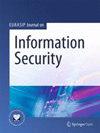基于 BN 和 WSN 的无线传感器网络节点故障诊断算法
IF 2.5
Q2 COMPUTER SCIENCE, INFORMATION SYSTEMS
引用次数: 0
摘要
无线传感器网络作为一种新兴的信息交换技术,在许多领域得到了广泛的应用。然而,在恶劣复杂的环境条件下,节点容易受到损伤。为了有效诊断节点故障,提出了一种基于贝叶斯模型的节点故障诊断模型。首先,对无线传感器系统的工作原理进行了全面的分析,并在此基础上推断出故障相关特征。利用充分样本特征的极大似然法构建贝叶斯诊断模型,并引入联合树模型进行节点诊断。针对贝叶斯模型在处理小样本数据时精度不足的问题,提出了约束最大熵法作为贝叶斯模型的预测模块。利用小样本数据获取初始模型参数,提高了模型的性能和精度。在参数学习测试中,有限最大熵模型在较小的35个数据集上以2.65的距离值优于其他两种学习模型。在节点故障诊断中,比较了三种模型的诊断时间,提出的诊断模型的平均诊断时间为41.2秒。在节点诊断准确率测试中,该模型的节点故障诊断准确率最高,平均诊断准确率为0.946,优于其他两种模型。综上所述,本文提出的基于贝叶斯模型的节点故障诊断模型在无线传感器网络中具有重要的研究意义和实际应用价值。通过提高网络的可靠性和维护效率,该模型为无线传感器网络的发展和应用提供了有力的支持。本文章由计算机程序翻译,如有差异,请以英文原文为准。
Node fault diagnosis algorithm for wireless sensor networks based on BN and WSN
Wireless sensor networks, as an emerging information exchange technology, have been widely applied in many fields. However, nodes tend to become damaged in harsh and complex environmental conditions. In order to effectively diagnose node faults, a Bayesian model-based node fault diagnosis model was proposed. Firstly, a comprehensive analysis was conducted into the operative principles of wireless sensor systems, whereby fault-related features were then extrapolated. A Bayesian diagnostic model was constructed using the maximum likelihood method with sufficient sample features, and a joint tree model was introduced for node diagnosis. Due to the insufficient accuracy of Bayesian models in processing small sample data, a constrained maximum entropy method was proposed as the prediction module of the model. The use of small sample data to obtain the initial model parameters leads to improved performance and accuracy of the model. During parameter learning tests, the limited maximum entropy model outperformed the other two learning models on a smaller dataset of 35 with a distance value of 2.65. In node fault diagnosis, the diagnostic time of the three models was compared, and the average diagnostic time of the proposed diagnostic model was 41.2 seconds. In the node diagnosis accuracy test, the proposed model has the highest node fault diagnosis accuracy, with an average diagnosis accuracy of 0.946, which is superior to the other two models. In summary, the node fault diagnosis model based on Bayesian model proposed in this study has important research significance and practical application value in wireless sensor networks. By improving the reliability and maintenance efficiency of the network, this model provides strong support for the development and application of wireless sensor networks.
求助全文
通过发布文献求助,成功后即可免费获取论文全文。
去求助
来源期刊

EURASIP Journal on Information Security
COMPUTER SCIENCE, INFORMATION SYSTEMS-
CiteScore
8.80
自引率
0.00%
发文量
6
审稿时长
13 weeks
期刊介绍:
The overall goal of the EURASIP Journal on Information Security, sponsored by the European Association for Signal Processing (EURASIP), is to bring together researchers and practitioners dealing with the general field of information security, with a particular emphasis on the use of signal processing tools in adversarial environments. As such, it addresses all works whereby security is achieved through a combination of techniques from cryptography, computer security, machine learning and multimedia signal processing. Application domains lie, for example, in secure storage, retrieval and tracking of multimedia data, secure outsourcing of computations, forgery detection of multimedia data, or secure use of biometrics. The journal also welcomes survey papers that give the reader a gentle introduction to one of the topics covered as well as papers that report large-scale experimental evaluations of existing techniques. Pure cryptographic papers are outside the scope of the journal. Topics relevant to the journal include, but are not limited to: • Multimedia security primitives (such digital watermarking, perceptual hashing, multimedia authentictaion) • Steganography and Steganalysis • Fingerprinting and traitor tracing • Joint signal processing and encryption, signal processing in the encrypted domain, applied cryptography • Biometrics (fusion, multimodal biometrics, protocols, security issues) • Digital forensics • Multimedia signal processing approaches tailored towards adversarial environments • Machine learning in adversarial environments • Digital Rights Management • Network security (such as physical layer security, intrusion detection) • Hardware security, Physical Unclonable Functions • Privacy-Enhancing Technologies for multimedia data • Private data analysis, security in outsourced computations, cloud privacy
 求助内容:
求助内容: 应助结果提醒方式:
应助结果提醒方式:


